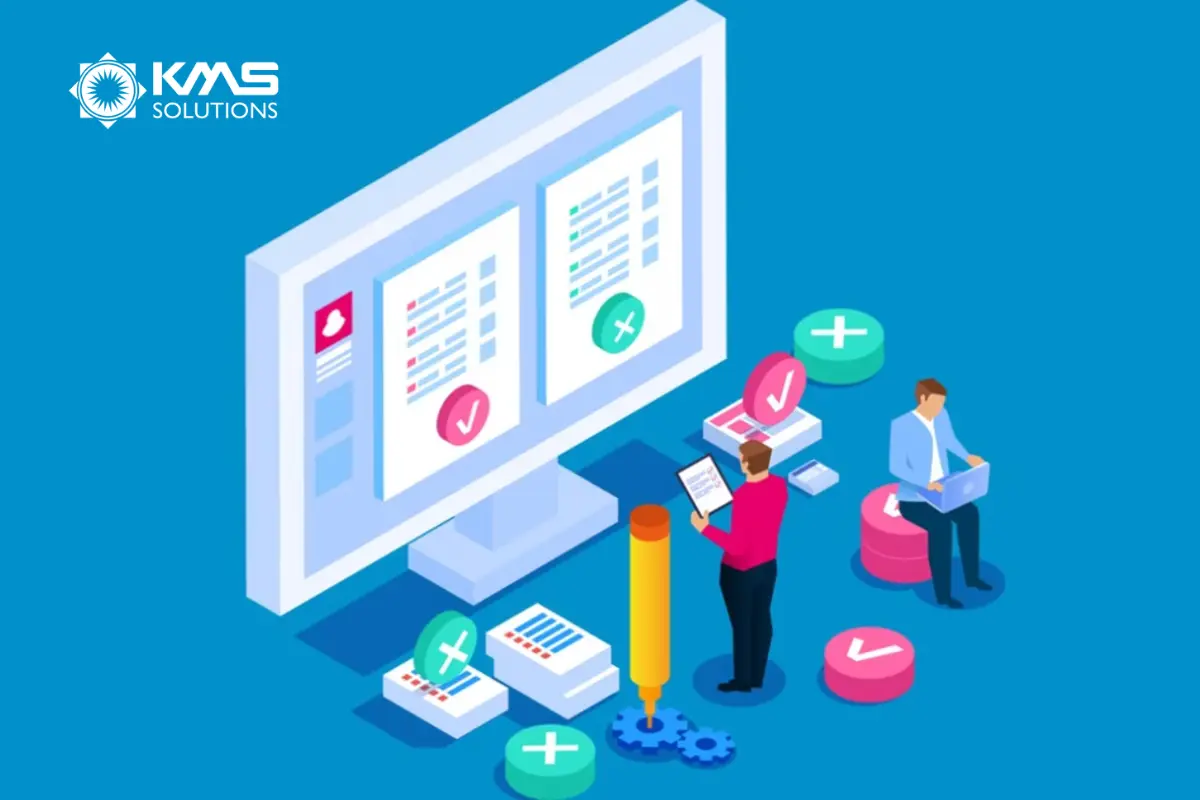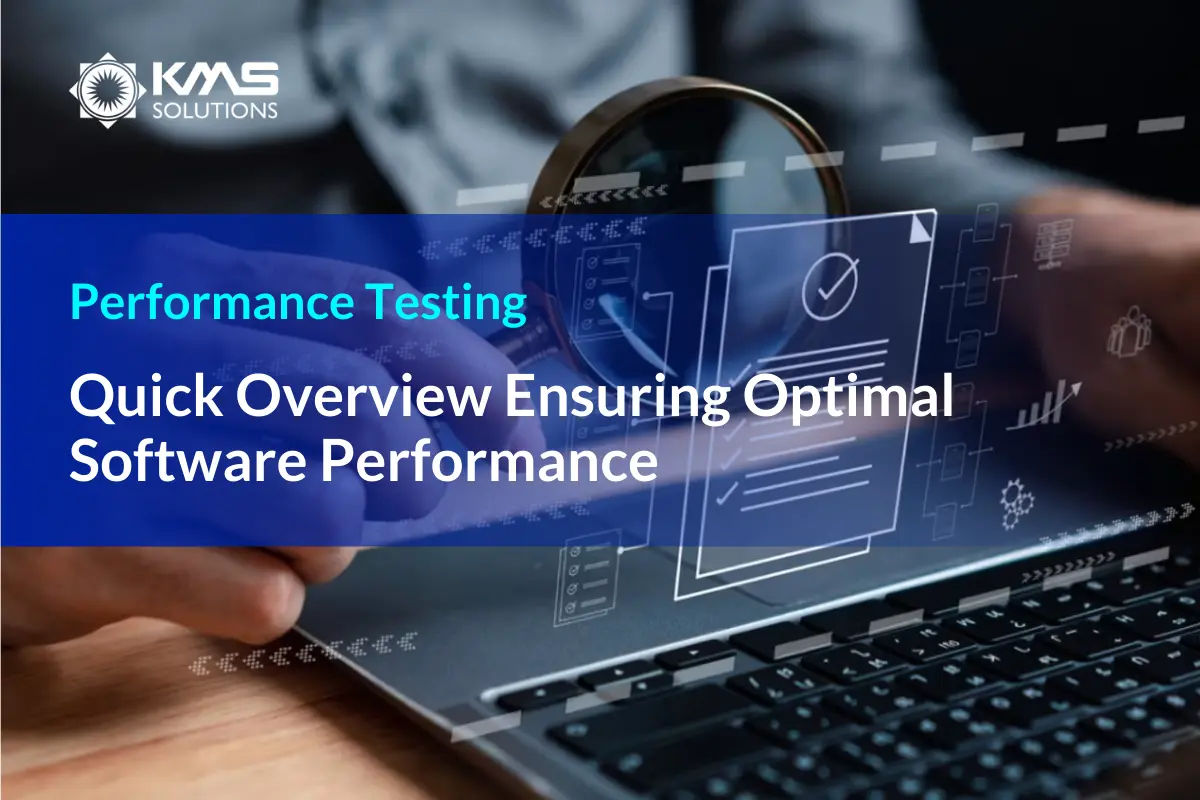Performance Testing in software testing is considered to be among the most essential and important types of enterprise software testing. It’s the go-to method to understand what would happen if an application is put under extreme conditions. Thanks to performance testing, testers can define appropriate corrective actions to ensure the app’s peak performance before it is launched to the market.
In this article, we will explore performance testing, its key components, and why it is essential for ensuring optimal software performance. We’ll also discuss how top-tier service providers like KMS Solutions can assist in deploying robust performance testing solutions for your software.
What is Performance Testing in Software Testing?
Performance testing is a non-functional testing process that evaluates how well a software application performs under specific workloads. It measures the system’s speed, scalability, stability, and responsiveness under various conditions. The goal is to identify performance bottlenecks, bugs, or areas for improvement before the software is released to end users.
Overall, performance testing in software testing is the practice of testing an application to ensure it can handle real-world scenarios, such as multiple users interacting with the system simultaneously or high traffic on a website during peak times.
Why use performance testing?
Organizations may use performance testing for several reasons, including:
- Diagnosing bottlenecks: Performance testing helps identify computing or communication bottlenecks that slow down a system. Bottlenecks are points within the system that hinder overall performance. For instance, even the fastest computer will underperform if its internet bandwidth is below 1 megabit per second. These issues may stem from hardware limitations or software-related problems, such as too many active applications or a corrupted browser file.
- Pinpointing software issues: It helps determine the source of software-related performance problems by highlighting areas where an application may fail or slow down. This is crucial for preparing systems for predictable events or high-demand scenarios.
- Verifying vendor claims: Performance testing allows organizations to confirm whether a system meets the manufacturer or vendor’s specifications. It also enables comparison between multiple devices or software programs to ensure they meet expected standards.
- Informing stakeholders: It provides key performance data—such as speed, stability, and scalability—helping project stakeholders stay informed of application updates.
- Preventing reputational damage: Releasing an untested application may lead to poor performance, causing user dissatisfaction and negative feedback. Testing ensures the software performs reliably before launch.
- Comparing systems: Organizations can use performance testing to compare different software or hardware systems in terms of speed, responsiveness, and stability, ensuring they choose the best option for their needs.

Types of Performance Tests
There are various types of performance testing; but in general, Load Testing, Unit Testing, Stress Testing, Soak Testing, and Spike Testing are the most popular ones.
Load Testing
Load testing is performed to simulate how the application behaves when it is loaded with increasing traffic or an increasing number of concurrent users. For example, a load can be a specific number of users logging in to a banking application to make a specific number of transactions within a specific duration. In this case, performance testing aims to find out the response time of all the involved functions to identify bottlenecks. Though load testing is perhaps the simplest form of performance testing, it’s the most useful when evaluating system behaviour, latency, bottlenecks, and throughput.
Stress Testing
A stress test is technically a load test, but the load exceeds the limits of the application under the test. The purpose of stress testing is to observe how the app behaves under such extreme conditions. Stress testing helps you know how and when your application crashes. One typical stress test is gradually increasing the load to see where and when the application violates non-functional requirements. This point at which the app collapses can be used to represent its capacity. For example, “the app can handle a total of 976 concurrent users when it starts to violate the requirements”.
Spike Testing
If you want to see how your app responds to sudden bursts of traffic, spike testing is the way. Spike Testing is very much similar to Load or Stress Testing, in which large traffic or users are loaded to the app; but a spike test comes in the form of a sudden spike in traffic. Typically, Spike Testing is used to see if the app’s performance might plummet or its functionalities collapse when put under sudden spikes, or if it can handle such extreme conditions. Other than that, it can be used to prepare for upcoming marketing or promotional events, where there would likely be a traffic burst to the app under test. Spike Testing is a must for applications that, from time to time, experience unexpected traffic increases.
Soak Testing
As another type of load testing, a soak test (also known as endurance test) still delivers an increasing load (i.e. increasing traffic or number of concurrent users) to the app, but for a longer period of time. The purpose is to see if such sustained intense activity would cause any performance drops or consequences, such as leakages of memory or disk space filling up. While it depends, the duration of a typical soak test is normally run for hours.
Scalability Testing
Scalability seeks to evaluate the application’s ability to scale up or scale down. A typical approach is to execute a series of stress tests, observe, and then gather data on how the app can scale. Attributes to measure include response time, throughput, hits & requests per second, transaction processing speed, CPU usage, and more. The results of scalability testing are usually used in planning and designing software development, which helps to reduce the cost and possibility of issues related to performance.
Metrics for Performance Testing
Organizations can use various performance metrics, also known as key performance indicators (KPIs), to assess system performance. Commonly used metrics include:
- Throughput: Measures how much data a system processes within a specific time frame.
- Memory: Refers to the available working storage space for a processor or workload.
- Response Time (Latency): The time between a user request and the system’s initial response.
- Bandwidth: The amount of data transferred per second, typically across a network.
- CPU Interrupts per Second: The frequency of hardware interrupts processed by the CPU.
- Average Latency (Wait Time): The time it takes to receive the first byte after sending a request.
- Average Load Time: The average time required for each request to be fulfilled.
- Peak Response Time: The longest time a system takes to complete a request.
- Error Rate: The percentage of requests that result in errors compared to total requests.
- Disk Time: The time taken for a disk to complete a read or write operation.
- Session Capacity: The maximum number of active sessions the system can handle simultaneously.
These metrics are crucial for performing various performance tests, allowing organizations to identify and optimize their systems effectively.

The performance testing process
While a performance testing process can vary depending on the nature of the application under test, you can refer to the following 7 steps as the basis.
Step 1: Identify the test environment
By first identifying the tools (both hardware and software) and network needed for performance testing, you will be able to create more effective tests, and also anticipate possible challenges that may happen during the process
Step 2: Identify performance acceptance criteria
Performance acceptance criteria typically are the goals and constraints for throughput, response times, and resource allocation. Normally, these criteria are set by business analysts only, but testers should also be involved in it as they are better at the technicalities of the app. But if you are unable to define any criteria, you can refer to other similar apps as the benchmark
Step 3: Plan & Design Performance Tests
The team assesses the variance of usage among different types of end-users and identifies possible scenarios to test all those use cases. It is important to simulate as many end-users as possible, design data for performance tests, and define key metrics.
Step 4: Configuring the test environment
The test environment is prepared for performance tests before they are executed. In addition, the related tools and other resources for the test run are arranged.
Step 5: Implement test design
All the performance tests are created as per the test design
Step 6: Run the tests
Performance tests are executed and monitored
Step 7: Analyze, adjust, and retest
Test results of the previous step are consolidated, analyzed, and shared across stakeholders. Then the testing team would adjust the tests and run them again to see if there would be any boost or drop in performance. Generally, improvements between each retest would decrease; therefore, you should stop when bottlenecks are deemed to be caused by the CPU. This is when you consider increasing CPU power.
Common Challenges in Performance Testing
While performance testing is essential for delivering high-quality software, it comes with its own set of challenges. Some of the most common hurdles faced during performance testing include:
- Simulating Realistic User Loads: It can be difficult to accurately mimic real-world usage patterns, especially when trying to simulate thousands of users interacting with the system simultaneously. Without realistic simulations, the test results may not provide meaningful insights.
- Test Environment Setup: Creating a test environment that accurately mirrors the production environment is another common challenge. Performance results can vary significantly if the testing infrastructure doesn’t match the real-world production environment.
- Interpreting Test Results: Performance testing generates a vast amount of data, including response times, throughput, and resource utilization. Extracting actionable insights from this data can be overwhelming.
- Continuous Testing in Agile/DevOps: In fast-paced Agile and DevOps environments, performance testing often takes a backseat due to tight release schedules. However, this can lead to performance issues post-deployment
Case Study About Performance Testing for Financial Software
Financial institutions rely heavily on the performance of their software systems to handle large volumes of transactions, complex calculations, and real-time data processing. Slow or unresponsive systems can lead to significant financial losses and compliance risks.
For example, one of our clients, a leading bank in Southeast Asia, was experiencing intermittent slowdowns in their online banking application during peak hours. Through rigorous performance testing using tools like JMeter and LoadRunner, we were able to simulate the high transaction volumes and identify specific bottlenecks in their system.
After optimizing their database queries and fine-tuning their server configurations, the application’s performance improved dramatically, reducing the average response time by 40%. This resulted in higher customer satisfaction and fewer complaints about service delays.

Conclusion
Performance Testing is key to an application before it’s released to the market. Therefore, you want to make sure that your app’s performance is tested before launching. While it’s true that no amount of testing is enough to ensure perfect performance, costly flaws and mistakes can be prevented by well-planned performance tests. Today’s businesses also apply Test Automation to enhance the effectiveness of their Performance Testing.
At KMS Solutions, we understand the critical importance of software performance testing in delivering reliable and efficient applications. Our team of experts is equipped with the latest tools and methodologies to help you identify and address performance issues early, ensuring your software performs flawlessly even under heavy usage. Contact KMS Solutions today to learn more about our performance testing services and how we can help you optimize your software for peak performance.











